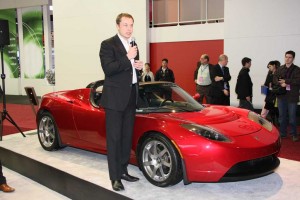
Top Gear officials defend their criticism of the Tesla Roadster - shown here with Tesla founder Elon Musk.
When Max Drucker paid over $100,000 for his Tesla Roadster he expected a sleek and speedy sports car, not a brick. But that’s apparently what he’s stuck with. After failing to heed warnings about not letting the charge of the battery in his 2-seat electric vehicle get too low the lithium-ion pack completely discharged and is now about as useful as, well, a lump of clay.
News of the problem surfaced this week on the technology website The Understatement, blogger Michael Degusta claiming he has been contacted by five Tesla Roadster owners whose sports cars have been “bricked,” tech-slang for a battery that is now deader than the proverbial doornail.
The California battery car start-up is dismissing the reports and largely putting the blame on its owners for failing to heed its warnings. But while Tesla may be technically – and legally – accurate — that seemingly cavalier approach is problematic at several levels.
With the maker getting ready to go mainstream with this year’s planned launch of the Model S sedan, it raises serious concerns about how Tesla will treat buyers even less familiar with lithium battery power than the early adopters who purchased the Roadster. It also underscores concerns about Tesla’s basic battery strategy, which relies on using virtually every possible watt that can be stored in a LIon pack. Competitors like Nissan, General Motors and Toyota are consciously designing their vehicles to maintain a “pad” to prevent catastrophic battery discharges.
Apparently, Drucker allowed his Tesla Roadster to drain down to the point it would need to be charged to keep driving. But rather than plug it in he left it for six weeks. By the time he came back and finally did try to recharge the car it was too late.
“The parasitic load from the car’s always-on subsystems continually drains the battery and if the battery’s charge is ever totally depleted, it is essentially destroyed,” writes blogger Degusta.
While it is still possible to rescue the battery the effort may result in significant damage limiting future range and performance.
And Tesla insists it has made all that very clear, even requiring buyers to sign a waiver acknowledging the issue and attesting to the need to keep the Roadster batteries plugged in when not being driven. Apparently, they lose a full 50% of their charge in a week after being completely recharged, though the subsequent drain is slower.
Tesla even uses a remote monitoring system – for owners who elect to opt-in – that will notify the company when the battery state of charge, or SOC, is dangerously low. Tesla then fires e-mails at the owner to plug in.
At this point, the maker says Drucker and others with “bricked” Roadsters are SOL, an acronym they also likely understand. The replacement cost is somewhere close to $40,000.
Several industry sources, however, say they are stunned that the maker is playing such a game of hardball, especially as it has used the high-performance Roadster – which can match the off-the-line launch of a Porsche 911 – to promote its technology and prepare it for going mainstream.
“We certainly would be doing everything we could to make the owner happy unless they absolutely intentionally caused the failure,” said the managing director of a high-line automotive manufacturer asking not to be identified by name criticizing a competitor.
Even if Tesla can get its position heard in the media, added another industry source, it’s questionable whether it will prove to be a more cost-effective move than simply replacing the batteries and making the owners happy.
For one thing, the bricking problem adds to public concerns about the benefits and reliability of lithium-ion technology, a matter that many analysts believe is going to result in a very slow growth for the battery car market.
But the issue also raises concerns about Tesla’s basic battery engineering strategy. The maker attempts to use virtually every “drop” of power its battery packs can produce to maximize range. That’s a distinctly different approach from what Nissan is doing with the Leaf battery-electric vehicle and General Motors’ approach with the Chevrolet Volt.
The latter, a plug-in hybrid, has a 16 kilowatt-hour battery onboard. But it only draws down about 10 kWh of that power, leaving a significant amount of energy in reserve even after the Volt shuts off the battery and switches on a small gasoline engine that then generates electricity to keep the car’s electric motors turning.
Tesla’s approach will allow the optional 85 kWh pack in the Model S to yield as much as 300 miles range, far more than it would get adopting GM’s conservative approach.
But while the added range will clearly be a selling point, what will happen if the headlines start reporting on widespread bricking in the battery sedan? That could short-circuit Tesla’s attempts to take electric propulsion mainstream.
